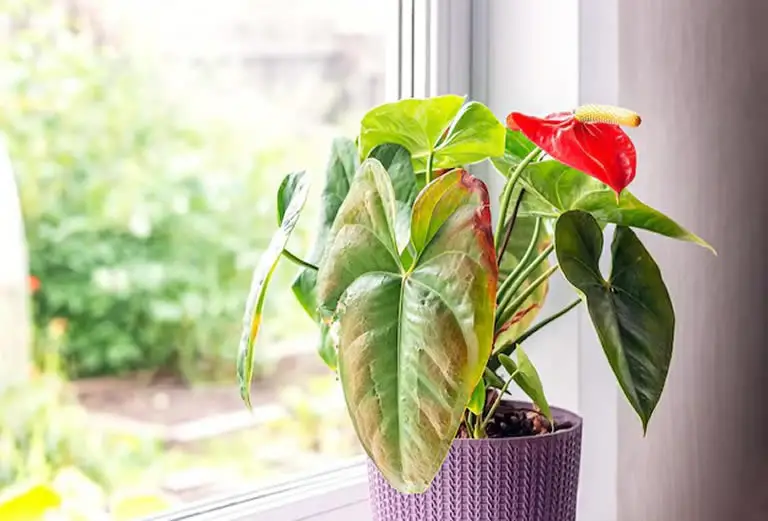Anthuriums are a favorite among houseplant lovers, known for their lush green leaves and, in many cases, their gorgeous, long-lasting blooms. But if you’ve started noticing brown leaves on your Anthurium, it’s natural to be concerned. Don’t worry—this guide will help you figure out what’s going wrong and how to get your plant back to looking its best.
The most common reason for brown leaves on an Anthurium is too much direct sunlight, which can scorch the foliage. Other frequent culprits include improper watering (both overwatering and underwatering), low humidity, and the plant adjusting to a new environment. Pinpointing the exact cause is the key to solving the issue.
While these are the main reasons for browning leaves, there are a few other potential factors to consider.
There is good news though. By checking your plant’s growing conditions and observing the pattern of browning and any other symptoms, you can get to the root of the problem and nurse your Anthurium back to health!
Table of Contents
- Why Does My Anthurium Have Brown Leaves? Here’s What’s Causing It!
- Too Much Sun! How Direct Light Causes Brown Leaves on Anthuriums
- Overwatering: A Common Cause of Brown Leaves on Anthuriums
- Acclimation: Why Your New Anthurium Might Get Brown Leaves
- How to Fix an Overfertilized Anthurium
- Pests: The Hidden Culprit Behind Brown Leaves on Anthuriums
- Disease: A Serious Cause of Brown Leaves on Anthuriums
- Low Humidity: A Common Culprit Behind Brown Leaves on Anthuriums
- Underwatering: A Common Cause of Brown Leaves on Anthuriums
- Cold Stress: How Low Temperatures Can Cause Brown Leaves on Your Anthurium
- Old Foliage: Why Lower Leaves Turn Brown
- Final Thoughts
Why Does My Anthurium Have Brown Leaves? Here’s What’s Causing It!
If your Anthurium’s leaves are turning brown, don’t panic!
Let’s go through the possible causes one by one so you can figure out what’s making your plant unhappy.
By identifying the issue—whether it’s just one factor or a combination—you’ll be well on your way to bringing your Anthurium back to health.
No matter if you have the popular Anthurium andreanum or a rarer variety, by the time you finish reading this, you’ll have a clear idea of what’s wrong and, more importantly, how to fix it!
Let’s dive in.
Too Much Sun! How Direct Light Causes Brown Leaves on Anthuriums
One of the most common reasons Anthurium leaves turn brown is excessive direct sunlight.
Strong, direct sun can scorch the leaves, leading to dry, brown patches—especially on the upper leaves or those most exposed to the light. If your plant sits in a bright spot with a lot of direct sun, this is likely the culprit.
Many people assume Anthuriums love the sun, but they actually thrive in bright, indirect light.
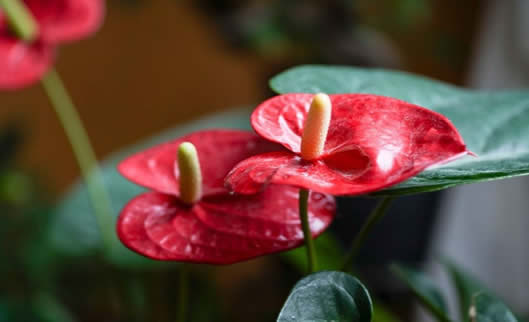
In professional nurseries, they’re grown under light levels of 18,000 to 25,000 lux, which, while bright, is only a fraction of the intensity of direct sunlight.
How to Fix Lighting Issues and Prevent Brown Leaves
The solution is simple—move your Anthurium to a spot with bright but indirect light, away from harsh sun exposure.
If you’re unsure how much light your space gets, try using a light meter app on your phone. There are plenty of free options in the Apple App Store and Google Play that use your phone’s camera to measure light levels.
I’ve personally found this super helpful for placing my plants in the perfect spot and tracking how light intensity shifts with the seasons.
Once you’ve moved your Anthurium, avoid pruning off the damaged leaves right away. Give your plant time to adjust to its new location.
Once you start seeing fresh, healthy growth, you can trim off the brown leaves to keep your plant looking its best.
Overwatering: A Common Cause of Brown Leaves on Anthuriums
Overwatering is one of the most frequent issues houseplant owners face, and it’s a top reason why Anthuriums develop brown leaves.
The key to spotting this problem lies in the pattern of leaf damage and the overall growing conditions.
If you notice yellowing lower leaves and brown leaf tips, your plant may be struggling with too much moisture.
But overwatering isn’t just about watering too often—it’s usually caused by poor drainage and consistently soggy soil.
Several factors can contribute to this, including:
- Using a pot that’s too large for your plant
- Planting in heavy, poorly draining soil
- Growing in a pot with few or no drainage holes
- Keeping your plant in low light, which slows water absorption and causes the soil to stay wet for too long
- How to Fix Overwatering and Save Your Anthurium
- If your Anthurium has brown leaf tips, along with yellowing lower leaves, its roots might not be functioning properly—root rot could already be setting in.
Here’s what to do:
- Remove the plant from its pot and inspect the roots.
- Trim off any rotten roots with sterile scissors or pruners. Rotten roots will be brown/black, mushy, smelly, and fragile—they all need to go.
- Gently shake off and rinse the remaining roots to remove any old soil.
- Repot your Anthurium in fresh, well-draining soil. A great mix includes equal parts peat or coco coir, perlite, and pine bark.
- If you had to cut away more than a third of the roots, prune back up to a third of the foliage to reduce stress on the plant.
- Place the plant in bright, indirect light and maintain high humidity to aid recovery.
- Water carefully—only once the top inch or two of soil feels dry to the touch.
Recovering from overwatering takes time, and your Anthurium will need a few months to bounce back. But with proper care, you should start seeing new, healthy growth before long!
Acclimation: Why Your New Anthurium Might Get Brown Leaves
It’s frustrating to bring home a beautiful Anthurium, only to see brown leaves appearing within a few weeks.
But don’t worry—this is often just acclimation, and it’s one of the less serious reasons for browning leaves.
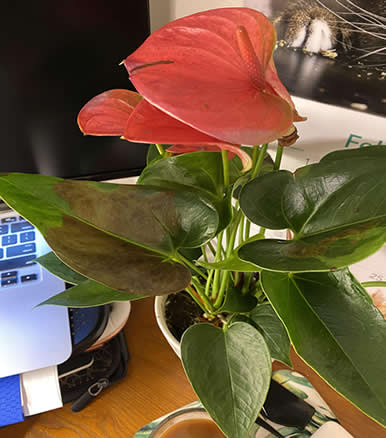
Anthuriums are typically grown in ideal, carefully controlled conditions at nurseries, so when they arrive in your home, they need time to adjust to changes in light, temperature, and humidity.
During this transition, you might notice a few lower leaves turning brown and falling off or brown spots forming along the edges of the leaves.
How to Minimize Brown Leaves from Acclimation
While some adjustment is inevitable, there are a few things you can do to help your Anthurium settle in smoothly:
- Buy from a reputable seller that keeps plants in good conditions before sale.
- If purchasing from a large store, try to buy soon after new stock arrives to reduce the time your plant spends in less-than-ideal conditions.
- Avoid ordering online when temperatures are below 50°F (10°C), as exposure to cold during shipping can cause stress.
- Once home, place your Anthurium in the best possible conditions—bright, indirect light, warm temperatures, and high humidity—to help it adjust faster.
A little patience goes a long way! Once your Anthurium settles in, it should start growing healthy, vibrant leaves again.
Overfertilizing: Why Too Much Food Can Harm Your Anthurium
Fertilizing is meant to help your Anthurium thrive, but too much of a good thing can backfire.
Overfertilizing is a common cause of brown leaf tips and brown spots, often starting with the best intentions—trying to give your plant everything it needs to grow strong and healthy.
Unfortunately, excess fertilizer builds up as salts in the soil, which can damage both the roots and foliage.
If your plant seems sluggish, isn’t growing as expected, or you notice a white or brown crust on the soil’s surface, overfertilization could be to blame.
How to Fix an Overfertilized Anthurium
If you suspect your Anthurium’s brown leaves are due to too much fertilizer, here’s what to do:
- Flush the soil thoroughly with water to dissolve and wash away excess fertilizer salts.
- Stop fertilizing for at least six months to allow your plant time to recover.
- If the soil has a heavy fertilizer buildup or you’ve used granulated fertilizer, consider repotting into fresh soil. While repotting can be stressful for the plant, it may be the best option for severe overfertilization.
How to Fertilize Anthuriums the Right Way
Anthuriums don’t need much fertilizer to stay healthy.
I recommend using a balanced synthetic fertilizer at half-strength every other month during the growing season.
If you prefer an organic approach, adding 10% compost or worm castings to the soil mix can provide slow-release nutrients, reducing the need for additional fertilization for up to two years.
With a little care, you can keep your Anthurium well-fed without risking fertilizer burn.
If you want to learn more about proper fertilization, check out my complete guide to feeding houseplants!
Pests: The Hidden Culprit Behind Brown Leaves on Anthuriums
Pests can be a sneaky cause of brown leaves on your Anthurium, usually due to direct damage from insects feeding on the foliage.
If you notice irregular brown or yellow spots or even tiny holes in the leaves, it’s time to check for unwanted visitors.
The most common pests that attack Anthuriums are thrips and aphids, though mealybugs and spider mites can also make an appearance.
The good news? Identifying a pest problem is as simple as taking a close look at your plant.
How to Treat and Prevent Pest-Related Brown Leaves
The key to dealing with houseplant pests is early detection. I always recommend giving your plants a quick check every time you water them.
Be sure to inspect:
✔ Both sides of the leaves
✔ Along the stems
✔ Even the soil surface (some pests hide here!)
Spider mites, in particular, can be hard to spot until the infestation is severe, so staying vigilant is essential.
If you find pests, take action immediately:
- Isolate the affected plant to prevent the pests from spreading to your other houseplants.
- Manually remove as many bugs as possible by wiping them off or rinsing the plant under a tap, hose, or shower.
- Use a natural pest treatment like neem oil, isopropyl alcohol, or horticultural oil spray once a week until the infestation is gone.
How to Prevent Future Pest Problems
One of the best ways to keep your Anthuriums pest-free is to quarantine any new plants for at least two weeks before introducing them to your collection.
This gives you time to spot any hidden pests before they spread.
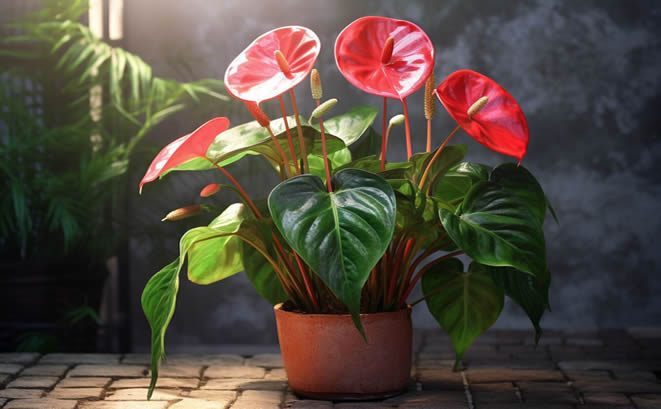
With regular care and monitoring, you can keep pests at bay and enjoy healthy, vibrant Anthurium leaves!
If you’d like a deeper dive into houseplant pest control, check out my full guide.
Disease: A Serious Cause of Brown Leaves on Anthuriums
If your Anthurium has irregular brown spots or patches that spread quickly, and you don’t see any pests, a fungal or bacterial disease may be the culprit.
Common plant pathogens like Fusarium, Pythium, Phytophthora, and Calonectria (fungal) or Xanthomonas and Pseudomonas (bacterial) can cause significant damage to your plant.
Unlike some other issues, plant diseases can spread rapidly and, if left untreated, may lead to the loss of your Anthurium.
How to Treat a Diseased Anthurium
If you suspect disease, act fast!
Here’s what to do:
- Prune off all affected foliage immediately using sterile pruning shears. This prevents the disease from spreading further.
- Unfortunately, topical treatments like fungicides or antibacterial sprays are rarely effective, so removing infected leaves is your best bet.
- If most of the plant is affected, the best option is to dispose of it to prevent the disease from spreading to other houseplants.
How to Prevent Diseases in Anthuriums
The best way to protect your Anthurium from disease is to keep it strong and healthy with good care practices.
Here’s how:
✔ Avoid overwatering, as soggy soil promotes fungal and bacterial growth.
✔ Provide bright, indirect light, since weak plants are more susceptible to disease.
✔ Ensure proper airflow and avoid excessive humidity without ventilation, as stagnant, damp air encourages infections.
With the right preventative measures, you can keep your Anthurium thriving and disease-free!
Low Humidity: A Common Culprit Behind Brown Leaves on Anthuriums
If your Anthurium’s leaves start losing their shine, develop brown tips, or get crispy edges, chances are low humidity is the problem.
This is especially common in winter, when indoor heating dries out the air, or during hot summer months when temperatures rise.
I personally ran into this issue last winter—despite keeping my houseplants warm, the humidity plummeted, and I started noticing brown patches on several of my Anthuriums.
If you’re seeing the same thing, don’t worry—this is totally fixable!
How to Prevent Brown Leaves from Low Humidity
The best way to prevent humidity-related issues is to monitor humidity levels in your home.
I swear by my digital hygrometer, which helps me keep an eye on both humidity and temperature.
Ideally, you should aim for at least 40% humidity, though some Anthurium varieties prefer 60% or higher.
Here are some easy ways to boost humidity:
✔ Group your plants together – Their combined transpiration creates a humid microclimate.
✔ Use a shallow dish of water near your plants – The evaporating water will increase moisture in the air.
✔ Move your Anthurium to a bathroom or kitchen – These rooms naturally have higher humidity levels.
✔ Skip the misting – It doesn’t really help with humidity in the long run.
✔ Use an electric humidifier – This is the most effective solution, especially if you pick one with a large water reservoir so you don’t have to refill it constantly.
With the right humidity levels, your Anthurium will stay lush, vibrant, and free from those pesky brown tips!
Underwatering: A Common Cause of Brown Leaves on Anthuriums
If your Anthurium’s leaves are turning brown and crispy, especially older leaves falling off or new ones developing dry edges, underwatering is likely the problem.
Wilting is another big clue—some Anthurium varieties, like Anthurium andreanum, even tilt their leaves downward and curl them slightly to conserve water when they’re thirsty.
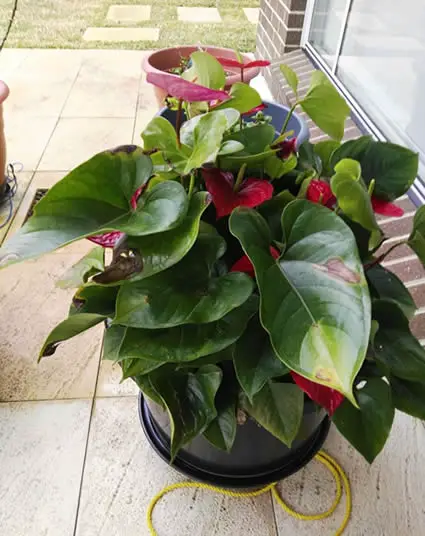
Luckily, this issue is easy to spot—dry soil and a lightweight pot are dead giveaways that your plant needs more water.
How to Prevent Underwatering in Anthuriums
If you struggle to keep up with watering, try getting into the habit of checking your plants a few times a week.
Instead of watering on a strict schedule, follow this simple rule:
💧 Water your Anthurium when the top 1-2 inches of soil feel dry.
🌿 Soak the soil thoroughly, then allow the pot to drain before returning it to its usual spot.
While underwatering is easy to fix, there are a few factors that can make it worse:
✔ Is your Anthurium rootbound? A pot full of roots will dry out much faster. If this is the case, consider repotting into a slightly larger pot.
✔ Is your soil too well-draining? While good drainage is important, soil that dries out too quickly can lead to constant dehydration. A mix that retains some moisture (but doesn’t stay soggy) is ideal.
✔ Is your plant getting too much heat or light? High temperatures and intense light cause water to evaporate faster, leading to drier soil. Moving your plant to a slightly cooler, shadier spot can help.
By keeping an eye on soil moisture and your plant’s environment, you can prevent brown, crispy leaves and keep your Anthurium thriving!
Cold Stress: How Low Temperatures Can Cause Brown Leaves on Your Anthurium
Anthuriums thrive in warm conditions, ideally between 59-86°F (15-30°C).
If exposed to temperatures outside this range, particularly below 59°F (15°C), your plant can suffer from cold stress, leading to brown leaves.
When this happens, you’ll often notice patchy yellowing on the leaves, which will soon turn brown and spread across the affected areas.
This damage typically worsens over a few weeks after exposure to the cold. Even a brief period of low temperatures can cause harm.
How Cold Stress Affects Your Anthurium
Cold stress usually results from your plant being left in a drafty spot during winter, or near an air conditioning vent in the summer.
Sometimes, plants are exposed to cold during delivery or on the way home from the store, which is also something to consider.
How to Prevent and Recover from Cold Stress
To protect your Anthurium, monitor the temperature of the area where it’s located.
I highly recommend using a digital thermometer, which can track maximum and minimum temperatures over time.
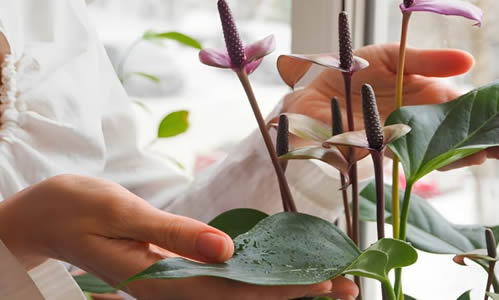
This way, you can quickly spot if your plant is being exposed to temperatures outside its comfort zone.
Unfortunately, recovery can take time—it can be several months before your Anthurium bounces back.
Don’t prune any damaged leaves until you see new, healthy growth.
With patience and proper care, your plant should recover and continue to thrive.
Old Foliage: Why Lower Leaves Turn Brown
It’s normal to see lower leaves on your Anthurium turning brown from time to time.
This is just part of the natural growth process, where the plant focuses its energy on producing new growth and shedding older, less useful leaves.
As long as your plant is only losing 1-2 leaves at a time, there’s no need to worry—it’s just part of the cycle.
However, always check on your plant’s care routine to make sure everything is still in balance. If you notice a sudden increase in leaf loss or browning, it could be a sign that something else is going on.
Final Thoughts
I hope this article has helped you identify why your Anthurium might be developing brown leaves and given you some practical tips on how to fix it.
If you’ve encountered a few hiccups along the way, don’t worry—it’s all part of the process of becoming a better plant parent!
Problem-solving is one of the best ways to learn how to grow healthy houseplants, and as you continue caring for your Anthurium, you’ll get even better at recognizing potential issues.
If you want to dive deeper into Anthurium care, I’ve written plenty of articles on various aspects of keeping them happy and healthy. You can also check out the latest anthurium available in our shop.

